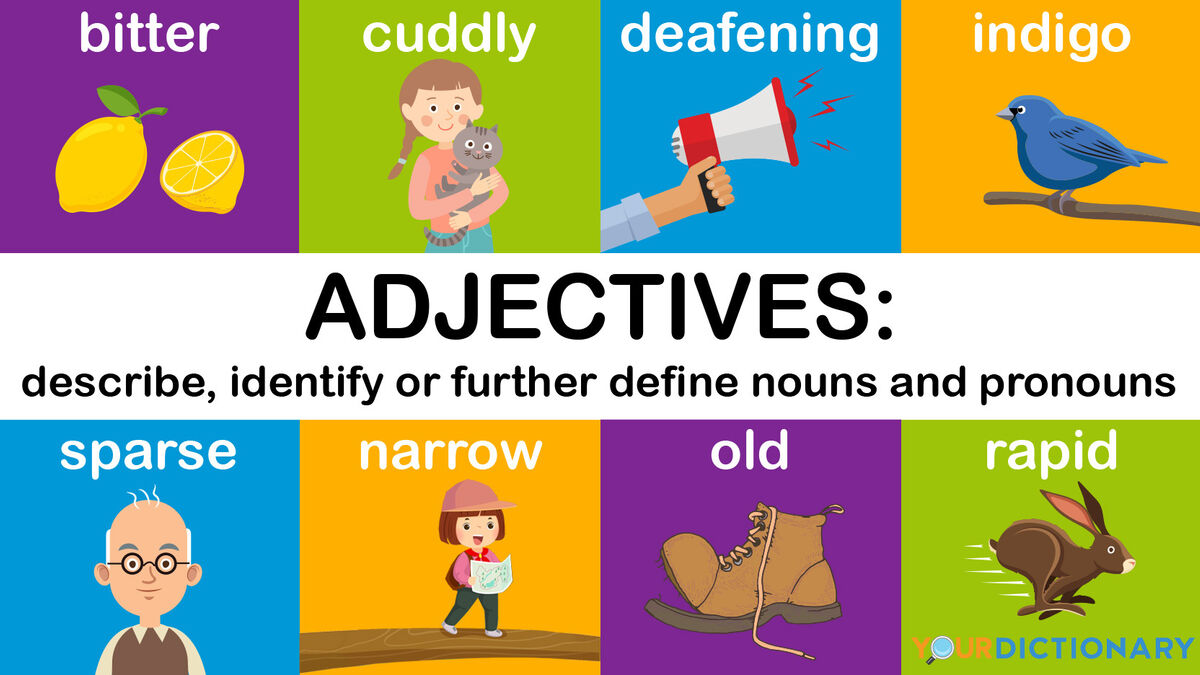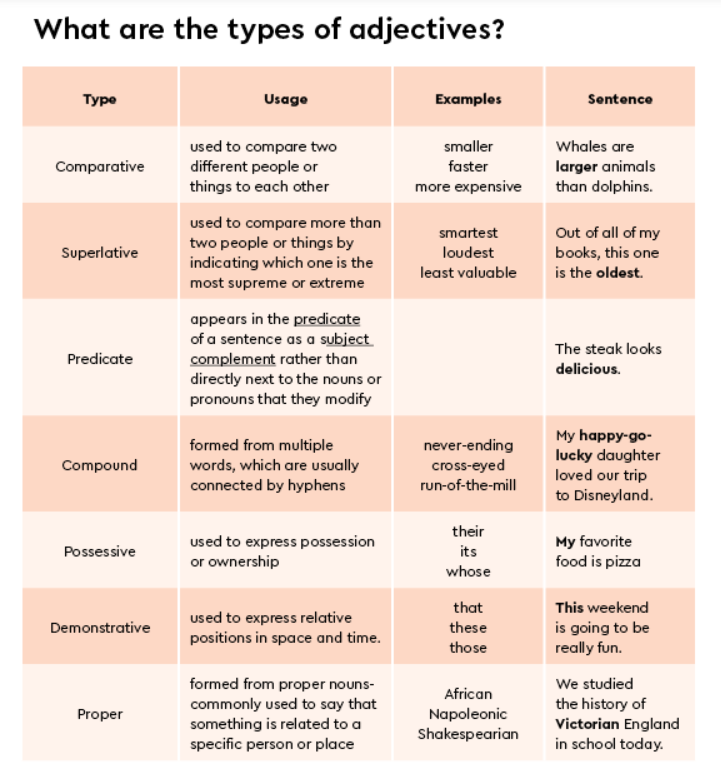Have you ever tried to describe a breathtaking sunset without the right words, or how about telling your friend just how hilarious that movie was last night?
Adjectives are the tools we use to create a vivid description of our experiences. They’re like vibrant colors on an artist’s palette, helping us paint vivid images with our words.
Now you might be thinking, what is an adjective? Is it merely a fancy word for ‘describing’ things or does it hold more weight in our language?
We often use these parts of speech unknowingly while speaking or writing but knowing their function can truly transform your communication skills.
Dive in and let’s explore this versatile tool of English grammar together!
Table Of Contents:
- Understanding the Nature of Adjectives
- The Role of Adjective Phrases and Clauses
- Unraveling Predicate Adjectives
- Proper Use of Adjectives in Sentences
- FAQs in Relation to What is an Adjective
- Conclusion
Understanding the Nature of Adjectives
Ever wondered, “What is an adjective?”
Here’s a quick grammar definition: An adjective is a word that describes or modifies a noun, providing additional information about its qualities, characteristics, or attributes.
Adjectives are an essential part of communication that contribute to the clarity and vibrancy of our statements.
An adjective can be seen as a linguistic fashion designer for nouns and pronouns, just like how a red dress or brown pencil stands out, adjectives help modify nouns to give them distinct characteristics.
The magic lies in their ability to transform simple phrases into engaging sentences.
Take for example: ‘the house,’ now add an adjective: ‘The big house’
The difference? It’s clear that the latter paints a more vivid picture by modifying the noun ‘house’ with the descriptor ‘big’.
Adjectives serve one main purpose – to describe or modify another word, typically nouns or pronouns. This modification helps us understand more about what kind, how many, or which one we’re talking about.
Adjective clauses work similarly but consist of several words working together rather than just one modifier. These offer additional information about the noun/pronoun they’re modifying.

Infographic from Your Dictionary
A well-placed compound adjective can make all the difference between ordinary text and compelling prose. They take on multiple forms including superlative adjectives (greatest), possessive adjectives (his/her), and interrogative ones (which).
A common misconception is that adjectives also modify verbs – but here’s where things get tricky. Despite some similarities, adjectives do not modify verbs.
Adjectives modify nouns and adverbs modify verbs. Getting this right will help your language be more precise and clear.
Different Types of Adjectives
Let’s dig into the fascinating world of adjectives. These vibrant words don’t just modify nouns; they bring sentences to life.
First on our adjectives list are compound adjectives. These combine two or more words to describe a noun in detail, for example, well-known author, heavy-duty backpack, open-ended question, red-hot chili peppers, and ice-cold lemonade.
The term coordinate adjectives might sound complex, but it simply refers to two or more adjectives that separately modify a noun. Think about the phrase “the tall, handsome man”. Here, both ‘tall’ and ‘handsome’ independently give us information about the man.
Adjective use doesn’t stop at these types though.
For instance, interrogative adjectives kick-start questions — remember asking for “which book” or “what color”?
Then there are possessive adjectives indicating ownership — your house, my car.
We also have indefinite adjectives, often used when we’re not being specific. If someone asks you how many cookies you want and your reply is “several”, you’ve used an indefinite adjective.
Descriptive adverbs add color and depth by describing characteristics such as size (‘big’), shape (’round’), age (‘old’), color (‘blue’), etc.
If pointing out specific things is what you need then demonstrative adjectives come in handy with terms like this, that, these, and those.

Infographic from Thesaurus.com
The Role of Adjective Phrases and Clauses
Adjectives play a key role in adding flavor to our language. They describe, identify, or quantify nouns and pronouns. But when it comes to adjective phrases and clauses, things get even more interesting.
A group of words that modify a noun or pronoun, consisting of an adjective (the head) and other modifiers, is called an adjective phrase. It includes an adjective (the head) along with any other modifiers.
For instance, “a red dress” becomes “a bright red dress”. The word ‘bright’ enhances the description – it’s not just any red dress; it’s notably vibrant.
Attributive nouns function as adjectives themselves.
Take the term ‘music box’. Here ‘music’, though typically considered a noun, serves as an adjective modifying the noun ‘box’.
You may wonder how we can recognize such instances. Well, check if you can separate them using commas without altering their meaning — this helps identify compound versus coordinate adjectives.
In cases like these, understanding ‘adjective order’ also proves beneficial for natural-sounding sentences: opinion before size before age.
Now let’s talk about those intriguing entities called ‘adjective clauses’. These are dependent clauses used as adjectives within sentences.
If I say “The girl who wears blue glasses”, here everything after ‘girl’ forms an adjective clause specifying which girl we’re talking about – quite useful in avoiding confusion during conversations.
A pivotal part of adjective clauses is the relative pronoun. Words like ‘who’, ‘which’, or ‘that’ often kickstart these clauses, connecting them to the rest of the sentence. The trick lies in using them accurately – a skill that improves with practice.
Remember: learning grammar is not just about knowing rules; it’s about understanding their application within context.
Comparative and Superlative Degrees of Adjectives
The world of adjectives isn’t just black and white. It’s full of shades, or in grammar terms, degrees.
We have the absolute degree that describes something on its own like a ‘big house’ or a ‘happy boy’. But what if we need to compare things? That’s where comparative and superlative adjectives step into the spotlight.
A comparative adjective lets you make comparisons between two entities. Think about it as putting two things side by side on an imaginary scale. If one is heavier (or lighter), taller (or shorter), or prettier (or less pretty), you’ve got yourself a comparison.
What if we want to pick out the most extreme example from more than two? This is where superlatives come in handy. They’re like giving gold medals at the Grammar Olympics for being ‘the fastest’, ‘the smartest’, or even ‘the least interesting’.
To visualize this transformation better, let’s take an adjective form like “bright”. In its absolute form, it remains simply “bright”. When compared with another object, it becomes “brighter”. And when it outshines everything else, it takes the superlative form of “brightest”.
Remember that not all adjectives follow this pattern. Some change completely in their comparative and superlative forms (like ‘good’, ‘better’, and ‘best’). But fear not. There are plenty of grammar resources to help you navigate these tricky waters.
Unraveling Predicate Adjectives
Predicate adjectives modify the subject of a sentence with the help of a linking verb. To give an example, consider this: “The sky is blue.” Here, ‘blue’ is our predicate adjective and it’s modifying ‘sky’, which is our subject. The linking verb would be ‘is’.
The beauty of predicate adjectives lies in their flexibility. They don’t need to sit right next to what they’re describing (like other adjective types). Instead, they take up residence after the linking verb.
Breaking Down Linking Verbs
You may ask yourself – what exactly are these ‘linking verbs’ that pair so well with predicate adjectives?
In simple terms, linking verbs connect or link subjects with words that provide more information about them.
Examples of linking verbs include “be” words like “am,” “are,” and “is,” these little helpers enable us to describe conditions or states being experienced by subjects.
Still puzzled over how this works? Let’s explore some examples: “My cat seems happy.” “Your idea sounds amazing.”
In both cases above we see linking verbs play the middleman between the subject (‘cat’, ‘idea’) and descriptor (predicate adjective; ‘happy’, ‘amazing’).
Proper Use of Adjectives in Sentences
A participle can sometimes act as an adjective too. This is one common mistake people often overlook when using adjectives in sentences.
Past participles (verbs ending with -ed or -en) describe a state or result from an action. For example, “The shattered glass cut my foot.”
Beware of something called the ‘brown pencil’ syndrome: overusing descriptive adjectives.
Sure, it might be tempting to write about the long brown wooden smooth vintage antique pencil on your desk but, let’s not go there. Rather than bombarding readers with endless descriptions, focus on those that truly matter for comprehension and impact.
Misusing comparative (‘bigger’) and superlative (‘biggest’) degrees of adjectives is another pitfall. To avoid this blunder, remember that comparatives compare two things while superlatives highlight extremes among three or more items.
A common trap is misusing predicate adjectives. These critters modify the subject of a sentence with the help of a linking verb. See some examples here. In sum, properly using adjectives can make your writing more vivid and engaging.
FAQs – What is an Adjective
What are 10 examples of adjectives?
Ten examples of adjectives are: blue, tall, short, bitter, sweet, young, old, brave, cowardly, and fast.
What is an adjective easy definition?
An adjective describes or modifies nouns and pronouns. It tells us more about them like what kind they are or how many there are.
What is an adjective kids will understand?
An adjective for kids would be words that describe things. For instance: soft teddy bear or red apple.
Conclusion
What is an adjective? They’re the color in our language’s palette. From modifying nouns and pronouns to differentiating them with vivid descriptions – that’s what an adjective does.
Digging deeper, we uncovered a treasure trove of different types: descriptive, demonstrative, interrogative, possessive … even compound and coordinate adjectives.
We journeyed through adjective phrases and clauses while dancing around attributive nouns. Comparative or superlative degrees matter when precision is key.
Predicate adjectives have their own spotlight too – playing nicely with linking verbs to modify subjects. And remember those common mistakes we highlighted?
So let’s take these grammar gems into our writing tool shed. Because understanding how to use adjectives can transform your communication skills beyond measure!